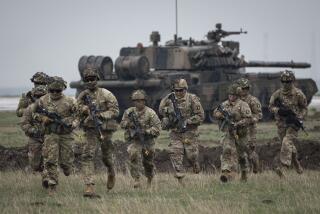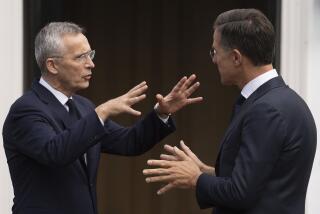Soviet Threat Not Over, NATO Chief Cautions
NAPLES, Italy — Urging caution in weighing President Mikhail S. Gorbachev’s disarmament overtures, NATO’s top military commander warned Tuesday that the Soviet threat to Western Europe “is not any less today” than it was when the Cold War first began to thaw.
Gen. John R. Galvin, the supreme Allied commander in Europe, said Soviet proposals should be judged in the context of the North Atlantic Treaty Organization’s 40 years of success in containing the threat from the East. He cautioned against giving too much credit to Gorbachev’s public relations victories and added that if the Soviets now offer defense cuts, “it’s our initiative they’re responding to.”
“I think we’re too self-critical,” Galvin told journalists here in advance of a NATO summit conference scheduled for this weekend in Brussels. “Not only has the Soviet Union been contained, but it appears to be turning around in a number of ways.”
He met reporters at NATO regional headquarters here before attending a ceremony at which Adm. Jonathan T. Howe, a 52-year-old San Diego native, succeeded retiring Adm. James B. Busey as commander of NATO forces and U.S. naval forces in Southern Europe. Busey has been nominated by President Bush to head the Federal Aviation Administration.
Galvin applauded the Soviet Union’s greater willingness to negotiate under Gorbachev but said that “the iron on the battlefield” is comparatively unchanged.
‘Have to Look at Capability’
“People look at intentions and say the intentions are changing,” he said. “That may be fine for some people, but I can’t look at intentions. I have to look at capability. Intentions are like moods; they can change again overnight. In the meantime, the Soviets are going through a transition which has dangers of instability, which is not really entirely predictable. I don’t think the threat as such, in terms of capabilities, is any less than it was three years ago.”
Nor, Galvin said, has the Soviet military changed greatly since Gorbachev took over. Soviet tank production, 3,000 units a year, is the same as it was in 1985, he said.
“The Soviets have announced that they will reduce 10% of the conventional force over the next two years,” he went on. “We have reduced something like 30% of the nuclear force on our side over the past 10 years, for which we didn’t take very much credit.”
Missile Dispute Unresolved
Secretary of State James A. Baker III said Tuesday in Washington that the dispute over whether to negotiate a reduction of short-range nuclear weapons is still unresolved. West Germany favors such negotiations. The United States, which seeks modernization of existing missiles, opposes cuts in nuclear strength before a reduction in the Warsaw Pact’s numerical superiority in conventional weapons.
“I think the Soviets seriously do want to negotiate,” Galvin said, “but obviously they want to arrive at a residual force, the remaining force after any reductions, which would be as good a force as possible.”
The Soviets, he noted, have systematically modernized their nuclear forces over the past decade.
More to Read
Sign up for Essential California
The most important California stories and recommendations in your inbox every morning.
You may occasionally receive promotional content from the Los Angeles Times.










